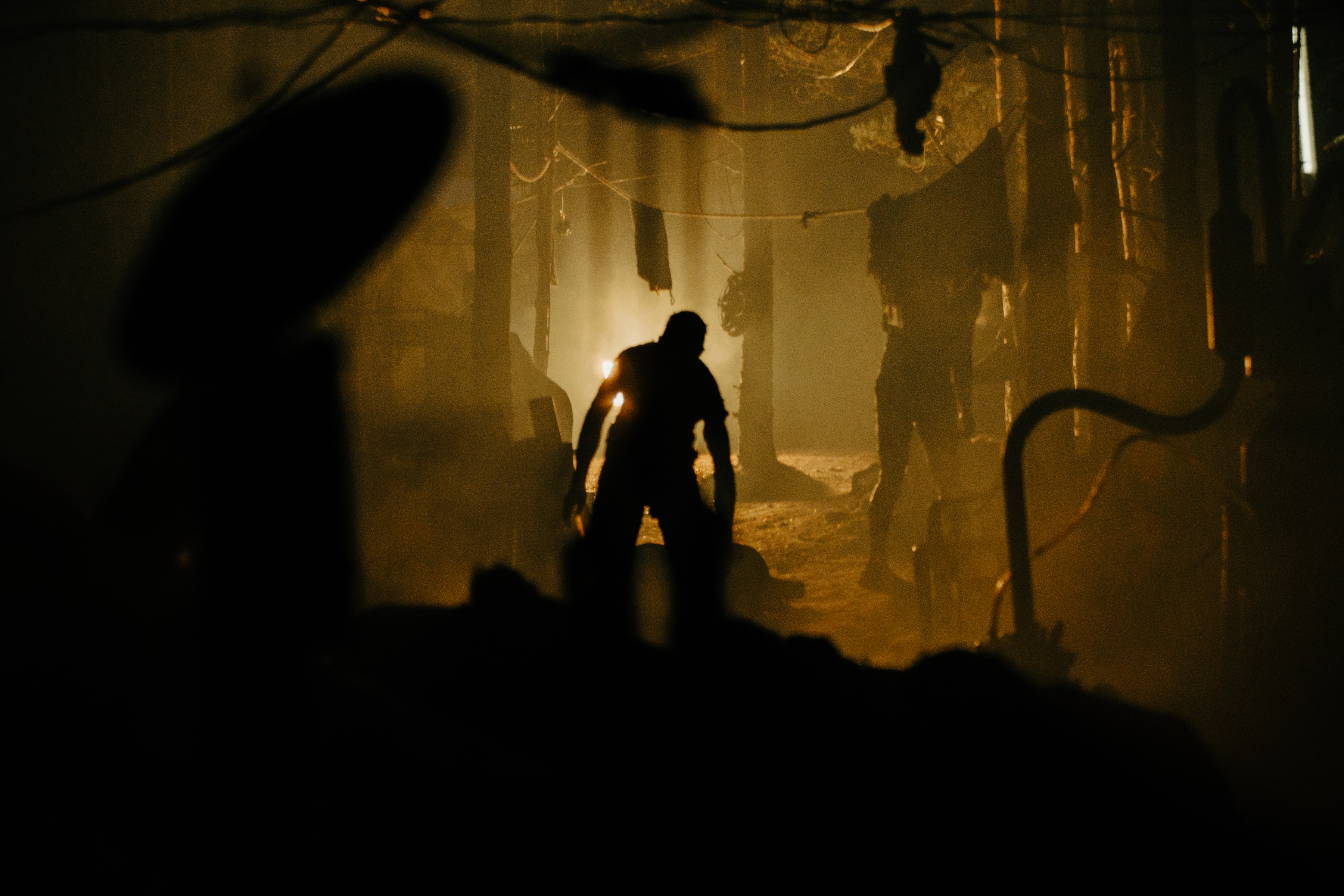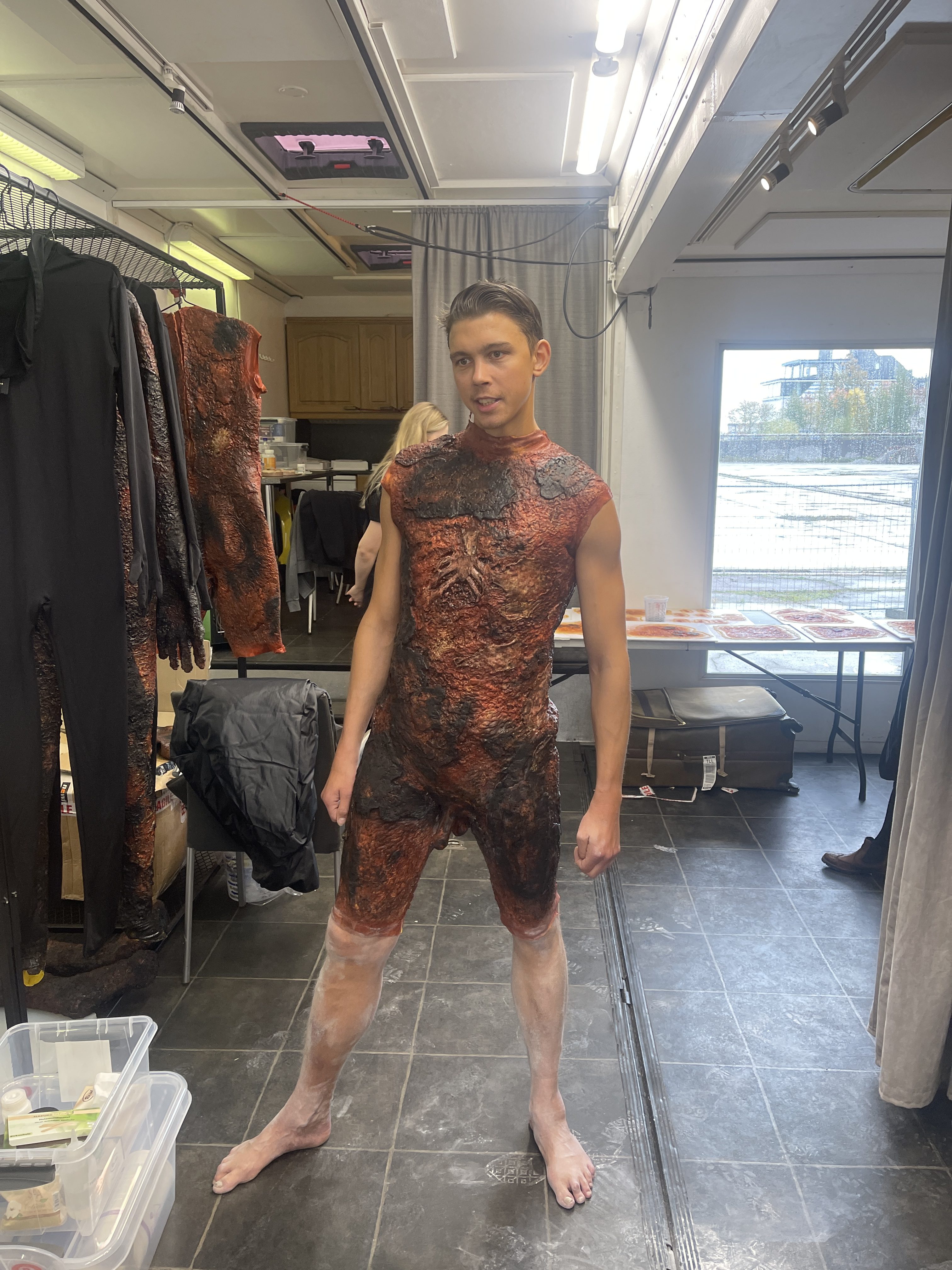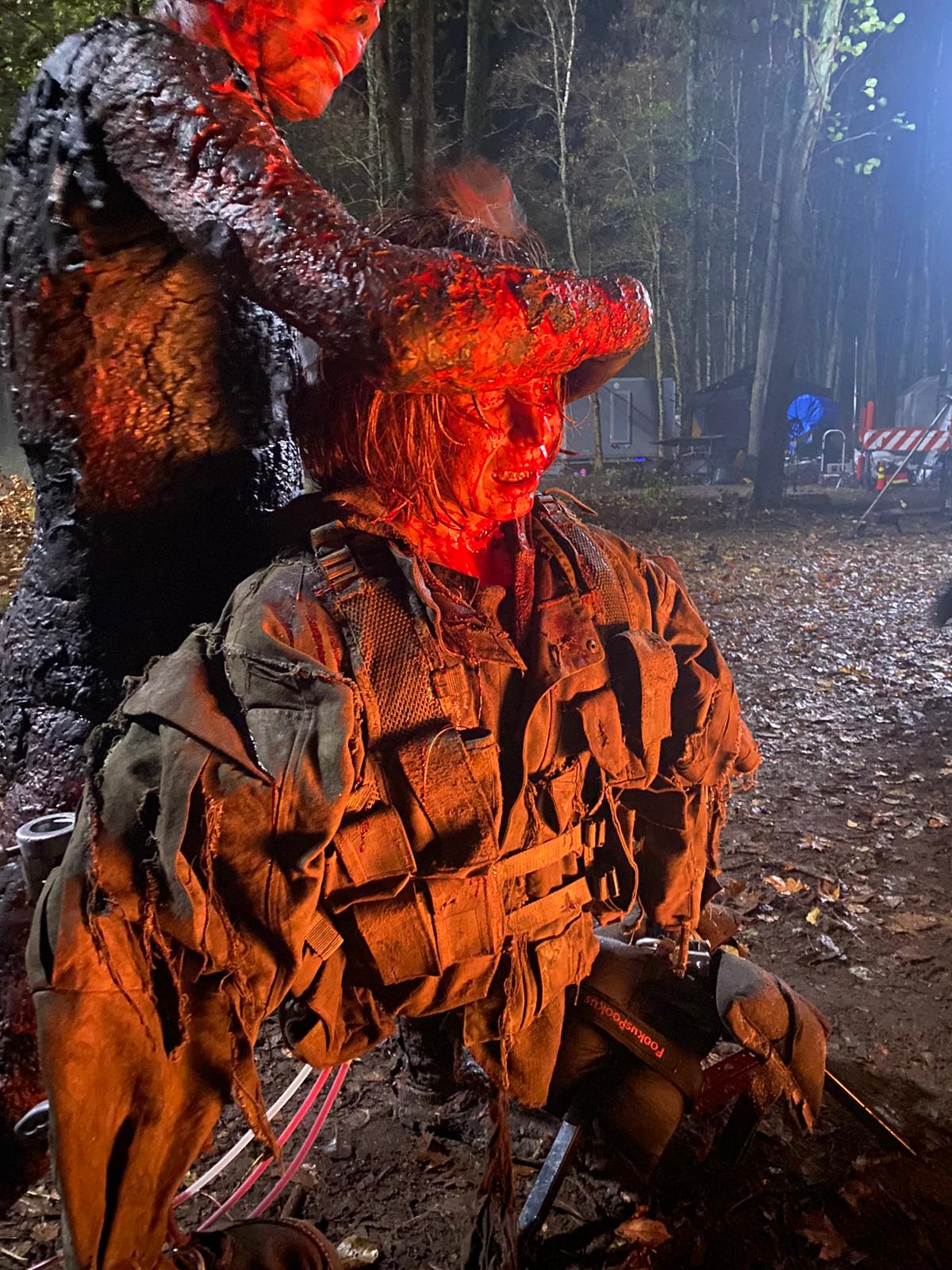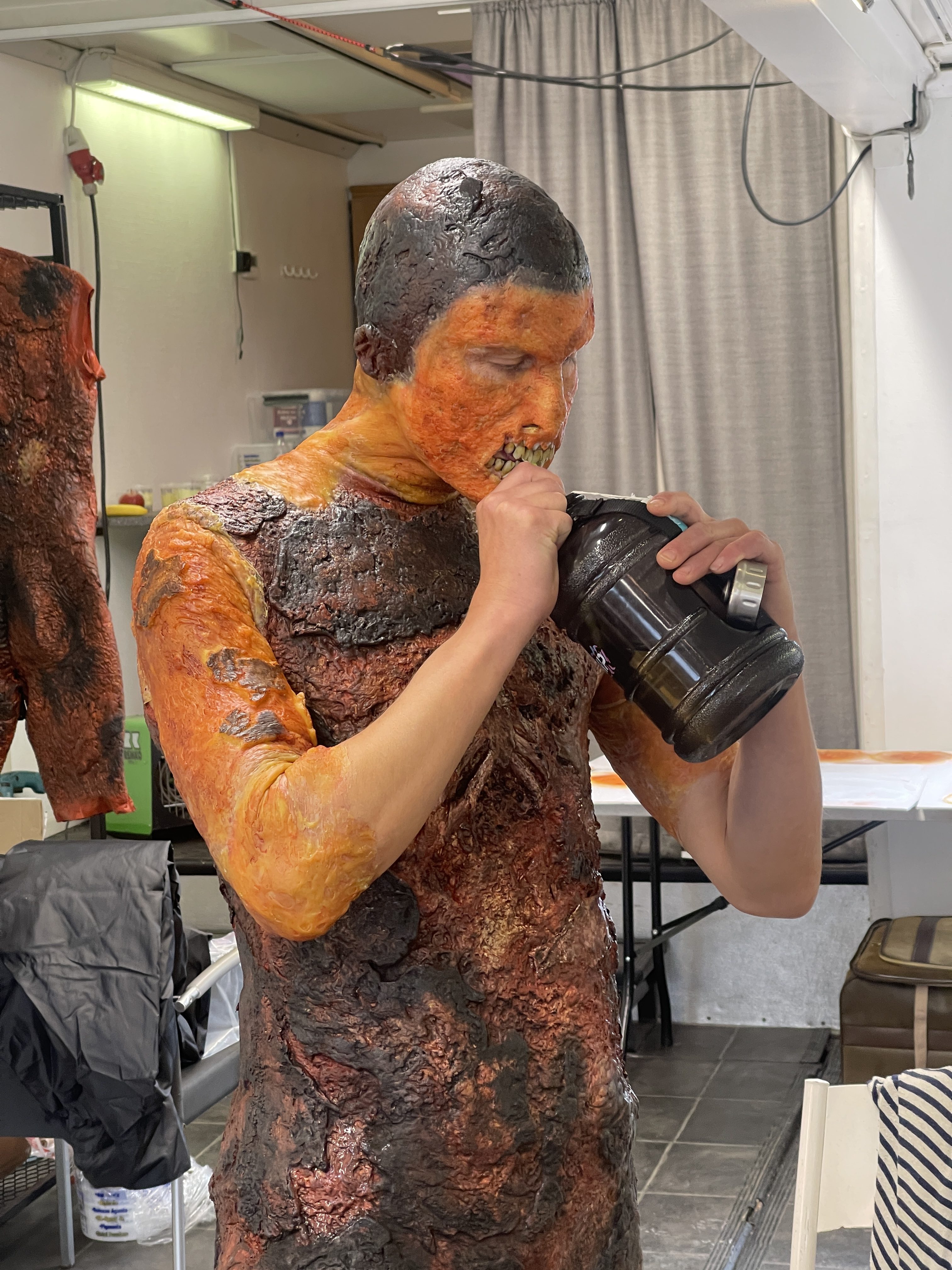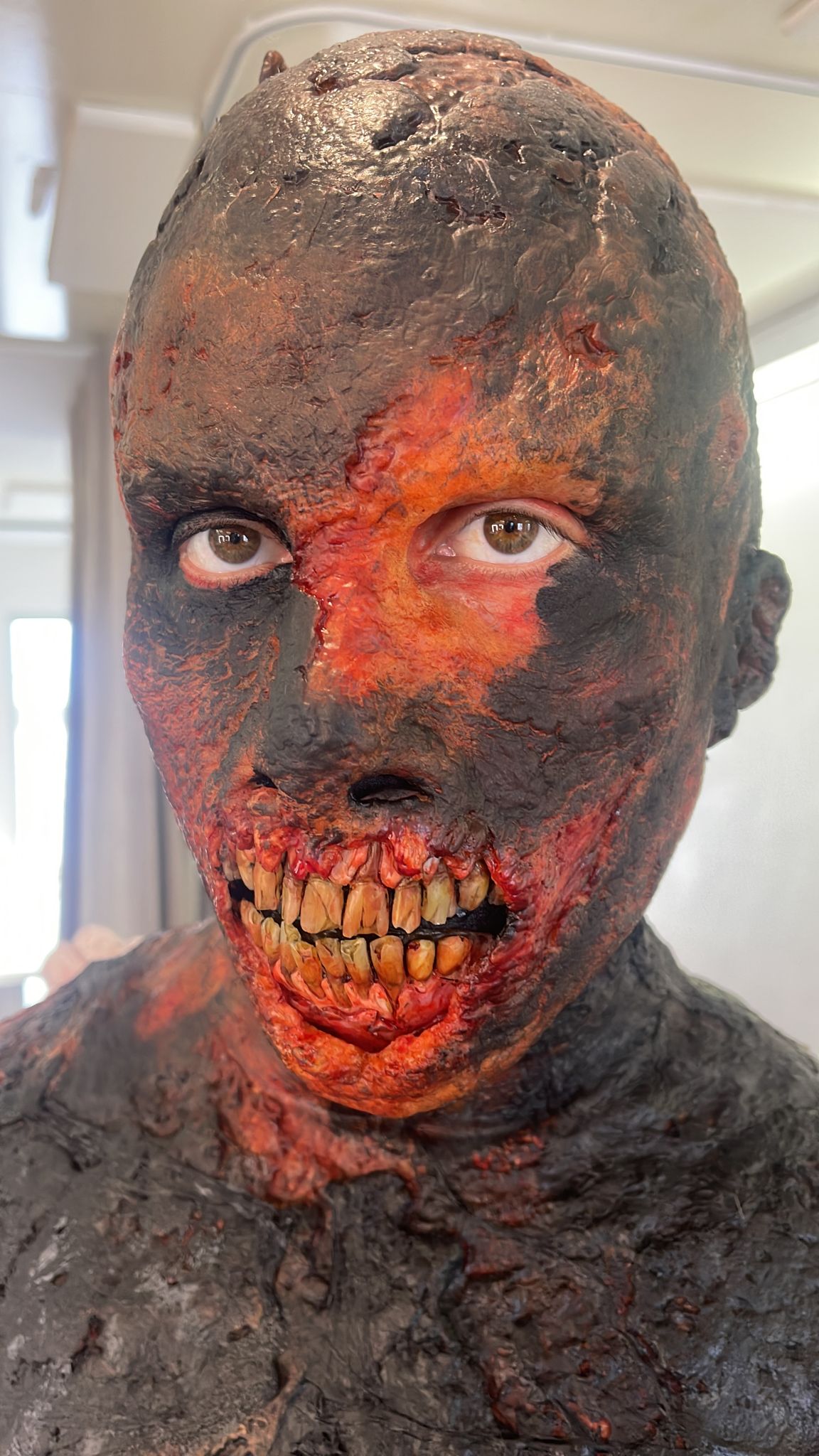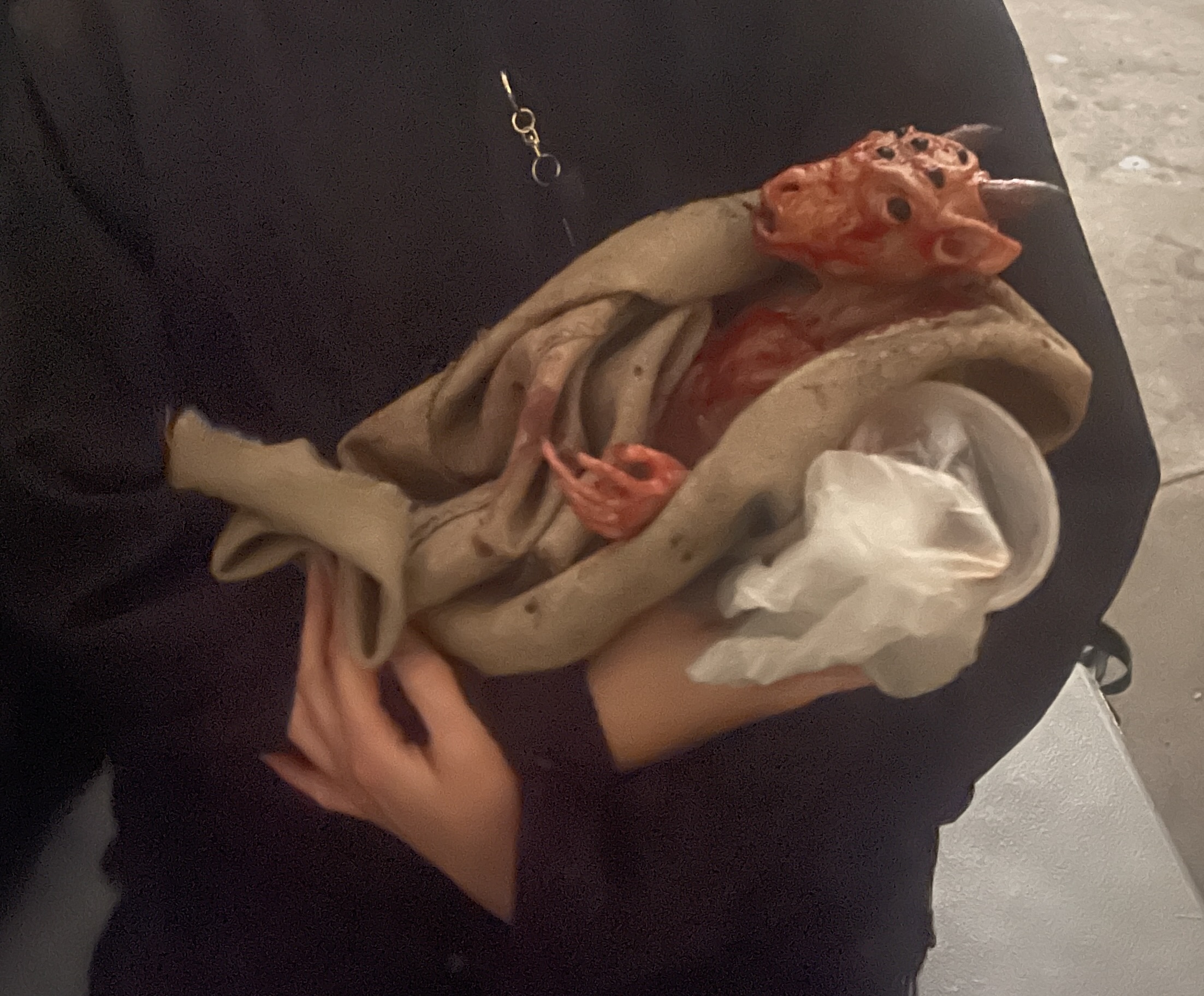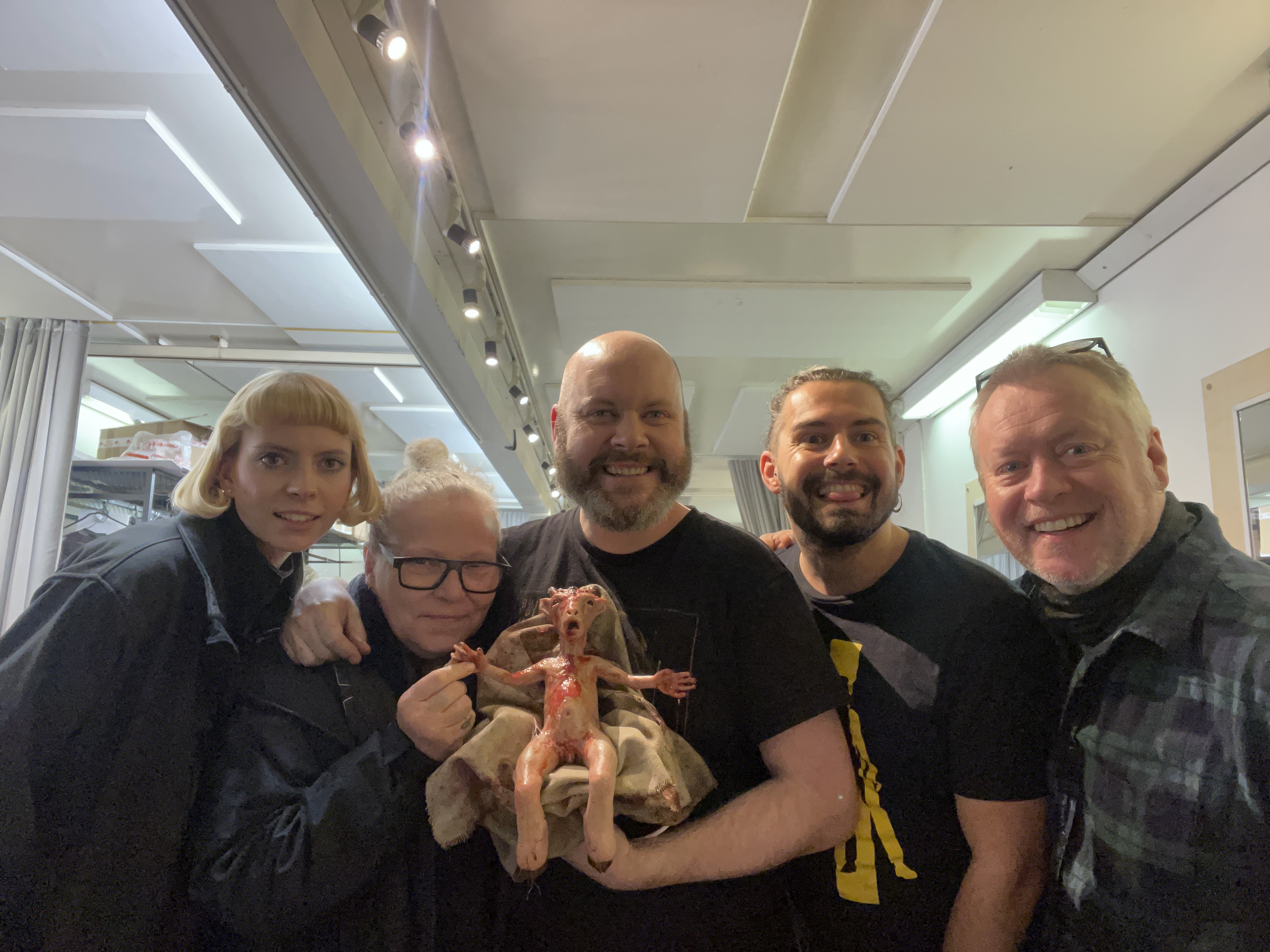It was the end of times, it was the worst of times. Azrael picks up somewhere after the Rapture — or, at least, that’s what people think happened. Or, to be even more specific, that’s what these people think happened; our vantage point in Azrael is limited to a small cult out in the wilderness somewhere, filled with people who believe they should “renounce their sin of speech.”
And it’s hard to fault them when there’s strange, blood-drinking demons running around the woods they live in. When the first title card drops, announcing that we are definitively post-end of the world as we know it, it all feels at once totally familiar and topsy-turvy — which is exactly how the monsters were supposed to be designed.
[Ed. note: This post now will start digging into later events and spoilers for the film, as well as some descriptions of the graphic origins of the creature design. Reader discretion advised.]
According to director E.L. Katz, the script originally likened the “Burned Ones” to bark, with “torched skin on top of much more raw, meaty gross stuff underneath.”
The goal for him, going in, was to create something that felt different from other creature designs. “I wanted there to be a little bit of an uncomfortable feeling of, I just don’t want to even look at their face that much.”
He brought on special effects artist Dan Martin because of his work on Possessor, a film Katz describes as having the same acutely “not fun” violence he wanted for Azrael: “There’s something about it that feels kind of assaulting, uncomfortable, and almost embarrassing.”
Ultimately, that is what the Burned Ones come across as — at least, at first. When Azrael (Samara Weaving) narrowly escapes being sacrificed to them at the beginning of the film, they seem vicious but lumbering. In the stark light of the day, they shuffle and shamble almost aimlessly until there’s blood in the air. But as the sun sets, their threat level shifts: Suddenly they’re running, jumping, even climbing trees.
This is, of course, a nice way to progress the tension of the movie. But it was also a dedicated choice to lace the Burned Ones mythology with something that wasn’t just purely zombie lore.
“There’s so many zombie movies; we’re so comfortable and familiar with the appearance of zombies,” Katz says.
“I don’t think we ever felt our hand was forced by trying to avoid zombie comparisons, because to be completely honest, it’s going to happen,” Martin says, noting that swearing them off entirely takes too much off the table for the story. “Really the main focus was just to serve the story, to make sure that the rules that we were giving the audience in the early scenes never felt contradicted, that it didn’t feel like we were hiding stuff from them and then pulling it out of nowhere. Everything had to feel like a natural progression.”
In light of that, the look of the Burned Ones didn’t come out of zombie canon. Instead, Martin and his production design team drew from a place they often turn to: “deeply upsetting” medical pictures. More specifically, in this case, they sought out photos of radiation burns. “We had conversations about what occurs anatomically inside the body when it is subjected to that kind of trauma, the dehydration of muscular tissue causing this particular pose in the body — the body starts to draw itself in because the muscles in the skin cook faster than the body, so they retract,” Martin says.
For him, the goal was always to balance the real with the unbelievable. Martin wanted to evoke the same feeling he had felt as a teen in the hospital, when he saw someone who had suffered really bad burns. “My stomach fell out; my body felt cold. I felt this rush of adrenaline,” he says. “I was in zero danger, and he was being treated. So it was the best version of that terrible situation that one can have. But my entire body was flooded with brain chemicals telling me that there was danger present. And that’s what I’m going for with a creature like this — because I want their mere presence to tell the audience that this is a bad situation.”
Exactly what the bad situation was is anybody’s guess. Azrael is sparse on the lore. What we can infer is: Sometime after an apocalyptic event, Azrael has attempted to escape the mute cult community that raised her, only to be brought back in by their vicious tactics and given to the Burned Ones that surround their camp as an offering. Since no one speaks any English in the film, Azrael moves like a funambulist over the taut tension of that set up.
And again, for a heightened reality like Azrael to work — and to feel not too far off from our own — it has to be clear about the rules, both for the world and the monsters.
“Having that through line is absolutely essential, and it’s really important for anyone who’s making an actual decision on set to know what’s going on at all levels really,” says Martin. You can certainly base discomfort or elements off of known entities. As he notes, sometimes the most impactful types of uneasiness come from something we have some frame of reference of pain for, like teeth, nails, or burns. “Everyone’s had a small version of those, and know how much that trauma is painful. So if you extrapolate that, make it bigger, they can naturally build that internally. They understand that escalation.”
Still, Martin and Katz are both a little resistant to overexplaining their logic beyond the bounds of the set. The film leaves a lot up to interpretation, letting biblical title cards and gruesome action do more of the talking. “We didn’t really set out to make this sort of Lord of the Rings kind of thing, where you have a book about, This is the rules of every creature in the world. It is an interpretive experience. And I think that’s what I think is fun about it,” Katz says.
“In this movie too — where you have some people listen to wind coming through a door or a hole in the wall, that’s just nature doing what it does. But some people, under the right circumstances, might go, That’s a greater force telling me that I need to start killing people in my community. Evil. And I think that’s the thing. You can interpret a story or an event or anything in a way that serves something a little bit more messed up.”
Of course, they do have an explanation for the Burned Ones, which is what allowed them to create and build. The gist: There was some sort of “extinction event” at some point in the past. The human characters of the film are the survivors of this thing, and the Burned Ones are… not as lucky. “The way we discussed them, they were the corpses of the people who had not survived this extinction event which had been co-opted by these demonic entities,” Martin says.
For Katz, the desire was always that they appear elemental, “a reminder of the end times” that just seemed to fill out the forest around you. Their skin gets a little “shredded” from ambling into branches over time. They walk around, they don’t seem to die; they’re simply there, always feeling otherworldly and yet present. In that light, it’s not hard to see how a cult might start to project onto them.
“The idea is they feel these things come from this sort of otherworldly hellscape. And when the end of the world happened — that fire, that was hell,” Katz says. “So when there’s evil that starts to come up within their family, their group, the cult — the only way to get rid of it is to sort of feed it to the source in some ways.”
But achieving the bone-chilling burned look wasn’t so simple — particularly when working in a forest in Estonia during the winter. Martin and his team had to be aware of how to design for characters who were wearing nothing at all, balanced against the needs of performers who were dressed only in prosthetics. And there were functionality elements as well: When Azrael gets chased up a tree by a group of Burned Ones, they would need a stunt performer who could hang off of a tree, without any sort of harness. Luckily, Felix Leech was both a creature performer and an aerialist who had just worked with Martin on Tarot playing the Hanged Man, so he already had a life cast of himself in a suspension vest.
That’s not all the prosthetics had to take into account: There were the “fancy Italian running shoes with separate toes” the Burned Ones performers all wore. There was the fact that performers might need to go to the bathroom or eat. There was whether or not the Burned Ones should have genitalia (an idea nixed not out of prudishness but rather, per Martin, because “penises are quite funny, and they can undermine severity”). And of course there was application time — which, even keeping it down to a minimum, still took about four hours.
Like in any production design department, some of the background players are wearing cheaper, rubber mask versions that you can’t see. But the Burned Ones who end up in the foreground — or in Azrael’s face — needed to thread the needle of being terrifying and strange, while also sometimes feeling just as (in)human as the cult.
“It’s like the human vessel is the vehicle that these aggressive spirits are occupying. They’re a raw destructive force, and they’re piloting this jalopy body that is probably not behaving exactly as they’d like,” Martin says. The team gave them human faces with milky eyes, to indicate they don’t see well. But give them just a whiff of blood, and they lock in.
The variety in how they appeared was based more on aggression level than anything. The production design team built out rib cages on one performer so they could have holes in her character’s skin to see the ducts beneath. Spines were more visible on Burned Ones like Leech’s tree-climbing creature so that they really stuck out in profile. “We don’t meet Felix, for example, until that tree scene. And he’s got a much angrier face,” Martin says, referring to the “out-of-mouth” dentures that make it look as if he’s chewed away his lips.
And ultimately, all that design work didn’t just have to stand on its own. It needed to beget the baby that brings about the end of the world — or, at least, the end of a world.
Like a handful of other movies this year — see also: The First Omen, Immaculate — Azrael ends with the birth of, well, something. It’s not hard to interpret the baby as the Antichrist; Martin cites Dick Smith’s design of the Nazarene Antichrist from the dream sequences in Jacob’s Ladder as the inspiration for the face and his many eyes. The rest is a “cocktail beast” of borrowed parts: human genitals and umbilicus (obscured); cloven hooves; slender loris arms (“one of nature’s creepiest real hands”).
It was ultimately the longest design process of the shoot, according to Martin. The result is a tangible, albeit fake, baby, an actual cast of the little guy that had a rod-controlled head and arms, a cable-controlled jaw, a little breathing bladder underneath a tiny plastic rib cage, and a digital blink. It’s the moment that the wonder of Azrael’s world, the strange supernatural possibilities, feel like they click into place as firmly unholy. But it all started far earlier, with the early thoughts on some feral demons.
“The bodies of the burnt people are [of] our world and they’ve been co-opted by this supernatural other, whereas this infant is — at least to my mind — the first time that other has been able to infiltrate a living body,” Martin says. “And I think it’s really, really important to have that lore running through the process when you are working on the film because it keeps you tethered to it. You don’t have to spoon-feed the audience, you don’t have to tell them stuff — in fact, I think most of the time films work better if you don’t. But the people making the film have to know.”
Azrael is now in theaters.
